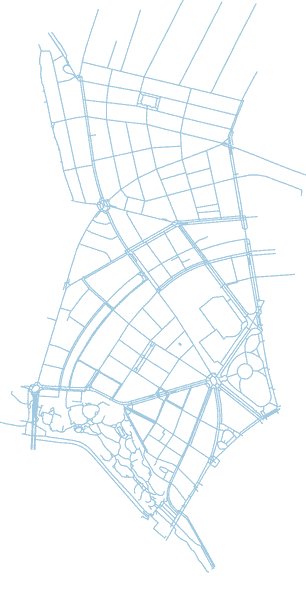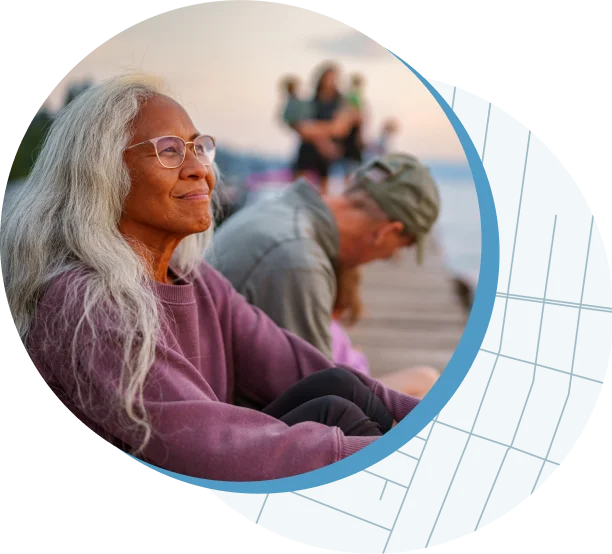
With wAIHA, there’s a lot going on
wAIHA is an autoimmune disease, which means the immune system is attacking the body.
wAIHA specifically attacks your red blood cells (RBCs).
This constant attack means that at some point, most people with wAIHA will experience debilitating fatigue and other symptoms. This can make it hard to participate in daily activities.
Everyone describes fatigue in a different way
When people hear the word “fatigue,” they may think it’s just another word for being tired. Fatigue is different. It can be debilitating—affecting your activities, work, or relationships.
Here are some ways you may describe fatigue:

Weak all over

Trouble starting or finishing things

Need to sleep during the day

Too tired to eat

Need help doing
usual activities

Have to limit social activity
Here’s the why behind some other wAIHA symptoms

Muscle pain
Oxygen delivery to your body’s tissues is reduced with wAIHA. This can cause your muscles to hurt and feel achy. It’s similar to the muscle pain experienced during intense exercise, when oxygen supply is limited.

Abdominal discomfort
wAIHA can cause your spleen to get bigger. This is called “splenomegaly” or an enlarged spleen. An enlarged spleen can cause discomfort or pain in the abdomen, or early fullness.

Chest pain
In severe cases of wAIHA, when the loss of RBCs is rapid, chest pain can occur. This can be related to the heart working harder to make up for the reduced oxygen.

Some symptoms of wAIHA can be life-threatening. If you experience severe symptoms, seek immediate care. The following symptoms are also an emergency:
- Severe anemia, where hemoglobin levels are less than 6 g per deciliter
- Low oxygen levels
- Confusion
- Deregulation of heart rate and blood pressure
Watch Ivy’s story. Ivy is a person living with wAIHA.
How is your story the same, if at all? How is it different?
Helpful tips for conserving energy
Consider making lifestyle changes

It starts with good sleep!
- Try to get 7–9 hours of restful sleep each night
- Create a relaxing bedtime routine
- Avoid caffeine, alcohol, and electronic devices (phone, computer, tablet) before bed

Pace yourself
- Break down big tasks into smaller ones
- Take short breaks often, even if you don’t feel tired
- Plan activities for when you have the most energy

Manage stress
- Use relaxation tools like deep breathing, meditation, or yoga
- Set boundaries! Say no to extra commitments
- Try to manage anxiety or worry and if you can’t do it on your own, reach out to a professional

Reach out to your healthcare provider
- Ask about tests for vitamins and discuss supplements, if needed. Low vitamin levels can worsen fatigue
- Ask about low-impact, light exercises such as swimming or yoga
- Discuss nutrition and hydration

Don’t be afraid to ask for help!
- Find support. Connect to others with wAIHA. Support groups can help you share, learn, and get advice
- Get help coping. Talking with a therapist or counselor can help manage your struggles

Keep a journal
- Track your symptoms. Note the day/time, activity, and what it feels like. This helps you learn your “triggers” and to manage your energy

Always have a plan! Make a simple, personal plan to help with your wAIHA tiredness and fatigue. Include things that you know help, like naps, rest breaks, breathing exercises, or relaxing.


Let’s talk warm autoimmune hemolytic anemia treatment
There are currently no FDA-approved products indicated to treat wAIHA.
Some people with wAIHA do not relapse after treatment, but unfortunately, many do. You may need long-term treatment.
An important treatment goal is to be in remission. Your healthcare providers may have the following targets to get you there:
- Stable hemoglobin levels (usually >10 g/dL)
- Normal lab tests (LDH, haptoglobin, reticulocyte, and bilirubin levels)
- Symptom management
Remission vs relapse

Remission means your disease is completely inactive for a period of time.

Relapse means your symptoms come back, sometimes suddenly—it is also called a “flare up.” A return of symptoms can mean your wAIHA is still active. Your healthcare providers may define a relapse by a drop in your hemoglobin levels below a certain value.
It’s important to remember that while some people will not relapse, there is currently no cure for wAIHA.
Current wAIHA treatment options
Standard treatments

Steroids
(also called corticosteroids)
- Likely the first treatment you’ll be prescribed after diagnosis or during a relapse
- Helps to quickly calm your immune system and stop it from attacking RBCs
- Usually started at a high dose and slowly reduced over time. Not meant for long-term use

B-cell depletion therapy
- Commonly prescribed as a second treatment after symptoms return or in combination with steroids as a first treatment
- Targets certain immune cells (called B cells) that make the antibodies responsible for attacking your RBCs
- Given in cycles rather than continually

Immunosuppressants
- May be used if other treatments like B-cell depletion haven’t worked well enough
- Helps to lower the activity of your immune system to stop the attack on red blood cells
- Often used as a longer-term treatment option

Splenectomy
- Sometimes considered if initial treatments haven’t helped or if you have an intolerance to other treatments
- Surgery to remove the spleen, the main organ where RBC breakdown occurs in wAIHA
- A one-time procedure that may lead to longer-lasting effects
Other treatments

Blood transfusion
- Replaces RBCs with donor blood (matched to blood type)
- Short-term treatment used when anemia is severe

Intravenous immunoglobulin (IVIg)
- Usually used in people who are very sick
- Consists of immune system antibodies from donors
- Can be used with other medicines such as steroids
- Short-term treatment to help improve symptoms
Everybody is different. Some people may be able to manage their symptoms with recommendations from their healthcare provider. However, other people have relapses that require ongoing, repeated treatment.
Speak to your healthcare providers to see what is appropriate for your wAIHA.
How do I talk to friends, family,
and coworkers about wAIHA?
Warm autoimmune hemolytic anemia. Wow, that’s a mouthful! Some people may only hear “anemia” and think, “Oh, I was anemic, and I just had to take some supplements.”
With wAIHA, that’s not the case. And because it’s rare, many people may have no idea what the disease really is.

That can be frustrating. It can also be tough when:
- Someone questions your ability to do things (for example, if you’re feeling fatigued and they can’t grasp how much it’s affecting you)
- People offer general wellness advice for increasing energy
- People speak about something they heard about and their experience (which may or may not be relevant to your experience)
You can also keep it simple with these facts:
wAIHA is:
- An autoimmune disease
- An invisible illness
- A rare disease
- Life-changing
People may not always understand, but you can help spread awareness! Try:
- Explaining to them how you feel and what effects wAIHA has on your body
- Sending them to a website where they can find simple information (like here!)
- Telling them how they can support you
Remember to be clear about what you can and cannot do. Setting up statements with “I can’t” and “I can” may be helpful. For example, “I can’t meet up for dinner tonight, but I can let you know how I feel tomorrow for a walk in town.”
Try it yourself:
“I can’t____________.
But I can____________.”
wAIHA at work
Disclosing your wAIHA at work may feel intimidating. You may fear judgment from peers and, worst case, termination.
It may be helpul to share how you work through your day. For example:
Every day around midafternoon, I tend to get very fatigued and have trouble focusing. I feel best in the early morning and try to front-load my workstream so the bulk of my work is done before the fatigue sets in.
Know your rights as an employee living with a chronic health condition. You may want to speak to a legal or human resources expert about this information.
How do I talk to my healthcare provider?
Have you ever been to a healthcare provider and completely blanked on everything you wanted to ask or say? That happens to a lot of people! You may want to keep a journal to help remind you what you’d like to discuss.
Here are some examples of things you may want to talk about with your healthcare team:
How long and how often you feel symptoms, especially if they are new or worsening
Wellness, such as nutrition, exercise, and mental health
Details for symptoms that interrupt your life, like fatigue. It’s OK to ask for help!
Physical therapy
Triggers for your symptoms (try keeping a journal) and how it affects your life
Pain management
It's also important to stay connected to your healthcare team so you can manage your wAIHA.
How do I parent or grandparent with wAIHA?

Being a parent or a grandparent uses a lot of energy. It can be frustrating when wAIHA symptoms like fatigue get in the way.
It’s important to be clear with loved ones about your energy level as it can change from day to day. Maybe last Sunday you could carpool but not this weekend.
Be clear about what you can and cannot do. Setting up statements with “I can’t” and “I can” may be helpful.
Try it yourself:
“I can’t____________.
But I can____________.”
Examples:
I can’t go to your hockey game, but I can watch the recording later with you.
Acknowledge the disappointment they may feel if you cannot do activities that other parents or grandparents can. Tell them you are open to talking about that at any time, even if they are angry. It’s okay to admit you’re angry too.
You may also want to have conversations with other people who are part of your daily life.
For example:
I have an autoimmune disease that affects me differently each day…
When speaking to a teacher:
I may be unable to volunteer for anything in advance, like class parties, but please keep me in the loop so I can be involved in ways that work for me.
When speaking to a bus driver:
If I’m not at the end of the driveway, my neighbor will bring my child to my house.

Here’s an example of something you may want to tell your loved ones when they ask or make assumptions about your disease:
“Anemia means there is a low amount of RBCs in my body. This means my blood doesn’t carry enough oxygen. But in my case, it can’t be cured by taking supplements. It’s an autoimmune disease that makes my body constantly attack itself. With wAIHA, it’s attacking those RBCs.”